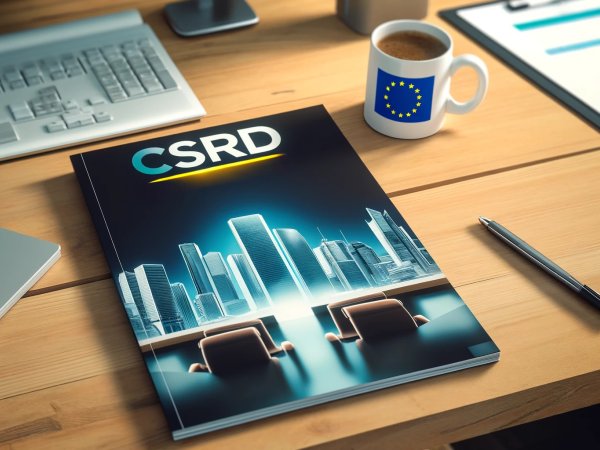On April 24, 2024, the EU Parliament approved the Corporate Sustainability Due Diligence Directive (CSDDD or CS3D). The new due diligence directive for companies is part of the series of laws known under the umbrella term "Green Deal". "This is a strong sign that legislation in Europe is setting important priorities when it comes to climate and environmental protection and respect for human rights. Fittingly, the CSDDD has now been adopted precisely on #FashionRevolutionDay, which commemorates the Rana Plaza disaster in Bangladesh," wrote Antje von Dewitz, CEO of Vaude, on her LinkedIn profile.
The Green Deal was conceived as a comprehensive approach to managing and reducing pollution in the broadest sense in order to mobilize more companies and investors to make an ecological transition. It is in line with the Sustainable Development Goals and the Paris Agreement of 2015.
The concrete implementation is an extra-financial or triple accounting report that will fulfill the requirements of the taxonomy, CSRD and CSDD. According to experts, an internal processing time of between twelve and eighteen months is required, depending on the size and maturity of the company. In the meantime, how can we take the right measures in terms of governance and corporate compliance? What to look out for when sourcing.
One of the most important documents available in French is the guide of the 'Autorité de Normalization Comptable (ANC) on the use of environmental, social and governance (ESG) indicators. All information is available in English on the website of the European Financial Reporting Advisory Group (EFRAG) website free of charge. This provides guidance for new factors to be included in financial reports.
- Context and objectives: In France, this regulatory package came into force at the beginning of 2024 and will gradually become mandatory based on turnover and number of employees. The disclosure deadlines extend from 2026 to 2029. It serves to apply ESG indicators in order to improve the transparency and relevance of financial reporting.
- Scope and principles: To meet the specific needs of each company, a tailored approach is recommended that emphasizes aspects such as resource management and social rights. Depending on the circumstances and sector, there are approximately 600 physical control points.
- Priority challenges: The key ESG challenges are to recognize impact and express it in data. Collected data needs to be digitized and measured - this includes socio-environmental impact, number of products, waste, customs and financing information, etc. The work of collecting and securing data can be simplified with the help of artificial intelligence.
- Main indicators: Double materiality is a prerequisite for CSRD. The recommended production indicators relate to impacts in the broader sense (CO2, biodiversity, principle of fairness and inclusion). Internal governance indicators are also crucial.
- Communication and validation: Progress on ESG should be reported transparently, through independent validation mechanisms that ensure the accuracy and reliability of the information provided. Internal communication mobilizes teams for a complex and laborious project. Stakeholders play a crucial role in avoiding greenwashing.
- Regulatory developments: In the textile sector, it is important to follow these closely. New laws on product sustainability and supply chain transparency can have a significant impact on financial reporting requirements. The EU law on due diligence (CSDDD) is part of the developments and is expected to be declared legally valid in the course of 2024.
These terms are not compliance instruments, but transitional measures. They require systems for classification (taxonomy) and for measuring and hierarchizing impacts (double materiality). The EU's green taxonomy identifies environmentally sustainable companies that do not exacerbate climate change. Like an "environmental compass", it was introduced by the European Commission to make private investments climate-neutral by 2050.
The cornerstone of this system is double materiality, which compares impacts against the criteria of the "real" economy. If the impacts, risks or opportunities identified by this double materiality are significant, they must be included in the company's non-financial report.
- Financial materiality refers to the positive and negative impact of sustainability issues on the company's financial performance.
- Impact materiality refers to the positive and negative impacts of the company on its economic, social and environmental environment.
- The procurement and production of clothing, shoes or equipment are subject to double materiality.
- They serve to increase transparency and clarify strategic decisions in the areas of purchasing, human resources and investments.
- Companies that do not comply with the legislation or do not take its effects into account risk not only sanctions but also no longer being financed or insured in the future.
In Europe, the directive on corporate sustainability reporting is the result of a European initiative that obliges large companies to report on their non-financial activities. It is a supplement to financial guidelines that have already been adopted. Based on the "European Sustainability Reporting Standards (ESRS) this more specific regulation defines the content and presentation of the information contained in the sustainability report. The ESRS also provide guidelines on the methods used, such as double materiality or value chain analysis. It significantly revises the requirements of the Non-Financial Reporting Directive (NFRD).
Disclosure obligation: This means that only the process will be audited for the time being.
- Gradual introduction: The first companies will have to apply the standards from the 2024 financial year and the reports will be published in 2025. At European level, the results are to be audited and companies sanctioned from 2028/2029. With the following obligations:
- 2025 (for the 2024 financial year): Large companies that currently fall within the scope of the Non-Financial Reporting Directive (NFRD), i.e. public interest entities with more than 500 employees
- 2026 (for the 2025 financial year): All large companies that are not currently covered by the Non-Financial Reporting Directive (NFRD)
- 2027 (for the 2026 financial year): Capital market-oriented SMEs (with opt-out option until 2028), small and non-complex credit institutions and group-owned insurance companies
- 2028 (for the 2027 financial year): All companies covered by the CSRD, including non-EU companies with EU branches or subsidiaries

The ESRS serve to identify the sources of environmental impacts and set priorities for the reduction of internal and external, created and suffered impacts, including mechanisms for verification (e.g. the carbon footprint). The material topics of the company's own sector that are irrelevant for the CSRD report are justified with the help of the double materiality matrix. They also make it possible to understand and use the connections between sustainability issues, system transformation and performance criteria.
- General standards
ESRS 1: General Requirements
ESRS 2: General Disclosures
- Specific standards
Environment: Consideration of short-, medium- and long-term challenges and assessment of the risks associated with sustainability issues for the company itself. Analysis of the company's environmental impacts (climate change, pollution, water and marine resources, biodiversity, resource use and circular economy).
Social: Quality of employment in terms of social responsibility and respect for human rights, purchasing policy and supply chain management, consumers and users, ethical business practices and anti-corruption, promotion of diversity on boards.
Governance: Corporate culture, fair role allocation and remuneration, communication of the company's sustainability goals and the measures taken to achieve these goals. Management of relationships with suppliers, prevention and detection of corruption, etc.
None of the ESRS are absolutely mandatory, you can only avoid an ESRS if you can prove that you have no impact, which is almost impossible, especially in the environmental sector.
Specific ESRS standards for the textile sector are being developed and are due to be published by the EU in 2024/2025.
- Impact, risk and opportunity management (IRO)
- The IROs recognize positive and negative, suffered and caused impacts. They are used for measurement from the perspective of double materiality.
- Once the main climate-related risks and opportunities have been identified, assessed and quantified, the ESRS E1 standard requires companies to disclose their climate change mitigation and adaptation policies and related actions to address these challenges and opportunities.
- For both impact materiality and financial materiality, the law provides criteria for measurement: severity, extent, scope, irreversibility and circumstances arising from the risk or opportunity.
Questions you should ask yourself before publishing a report: - How can I process this ESRS depending on my sector and the IROs identified to maximize the benefits and minimize the negative impacts?
- How does this serve the sustainable financial transformation of my business?
Companies must also present a transition and mitigation plan that is aligned with a +1.5°C pathway. This will allow them to demonstrate to investors that they are addressing significant climate risks and/or are prepared to take advantage of opportunities.
Preparation and planning: Anticipating commitments also means guiding customer preferences, embodying the employer brand and meeting the challenges of environmental labeling and the digital product passport.
- Who? A dedicated team to define the scope and context with a cross-departmental strategy. Key positions to understand what challenges and who to contact to understand the impacts in the organization and those the organization is exposed to through its decisions (environmental, social, financial.
- Why? To prepare for future financing and investments, mainly from banks and insurers.
- What: Double materiality, ESRS and IRO of the sector in terms of purchases and therefore sourcing, design, logistics and storage decisions.
- How? You can add topics that are relevant to your own activity as they represent strong IROs. The law states that the product passport must be educational and easy to understand and complete, with a summary to consolidate on the materiality scheme. The risk maps and references for suppliers in purchasing must include a materiality matrix. This matrix can be completed with the help of IROs. In the outdoor industry, for example, we set ourselves targets and indicators on topics such as microplastics and the circular economy.
- With whom? Everyone must be involved: Governance, finance, CSR, purchasing. Cooperation with suppliers outside the EU is essential.
- For what? To create positioning, purchasing and product strategies that comply with the new reporting requirements and incorporate more ESG considerations into their decisions. This will set the stage for future financing.
- By when? All final European CSRD information will be published and available on EFRAG from 2027.
Tips: Invite your departments to subscribe on social media using the keywords #financedurable #ISR #CSRD. Follow Alicia Boyano, Policy Officer at the European Commission, on LinkedIn or X.
CO2: Key indicators of impact materiality such as greenhouse gas emissions, emissions intensity and reduction strategies guide reporting. For financial materiality, the indicators are the CO2 intensity of investments. A carbon footprint is recommended for all actors in the supply chain.
Fairness and respect for human rights: General criteria are based on the recommendations of the International Labor Organization. For suppliers outside the EU, decent wages, health and physical safety of employees and ensuring non-discrimination (gender, racial or religious) are important.
Carbon financing quota: Companies will no longer be funded if they are not transparent about their funding sources and investments, including their suppliers. This is also a current criterion of the BCorp™ checklist.
Expansion of the scope: These measures have a significant extraterritorial impact on suppliers and import-export logistics. It is important to rely on organizations based in the countries of production (e.g. Business FranceFrench-German Chamber of Commerce and Industry, UN Fashion Alliance, etc.).
Solutions through cooperation: Sustainable Development Goal 17 shows the way: partnerships lead to the achievement of the goals. For productions in Asia, the organization China Water Risk and the projects of the United Nations Environment Program (UNEP) are important partners. Reducing the use of harmful substances in production processes, promoting safe and fair working conditions in partner factories and the efficient management of textile waste are crucial. Social audits are very important as they relate to working conditions, safety and exposure to chemical products. Organizations such as the Fair Wear Foundation, Bureau Veritas and the Initiative for Compliance and Sustainability (ICS) are valuable allies on these issues. They are based on the fundamental conventions of the International Labor Organization (ILO). NGOs work for reporting, CDP or Open Climate work together with large companies (e.g. Lenzing for CDP).
Fashion companies will be required to share information about their impact in two ways. These legislative and regulatory proposals will be revised at regular intervals so that the path of legislation will accompany operational transformation.
There is a double market value: the business results and the market value, which increasingly depends on the ability to embrace transformation. This will lead to greater transparency and prepare for future financing and investment by banks and insurers. They will also introduce educational elements into strategic decisions. All information will be published and available on efrag from 2027. Anticipating requirements also means guiding customer preferences, embodying the employer brand and responding to climate challenges.
In Part 1, we describe the rules for ecodesign and the Product Environmental Footprint.
- ISPO awards
- Mountain sports
- Bike
- Design
- Retail
- Fitness
- Health
- ISPO Job Market
- ISPO Munich
- ISPO Shanghai
- Running
- Brands
- Sustainability
- Olympia
- OutDoor
- Promotion
- Sports Business
- ISPO Textrends
- Triathlon
- Water sports
- Winter sports
- eSports
- SportsTech
- OutDoor by ISPO
- Heroes
- Transformation
- Sport Fashion
- Urban Culture
- Challenges of a CEO
- Trade fairs
- Sports
- Find the Balance
- Product reviews
- Newsletter Exclusive Area
- Magazine









